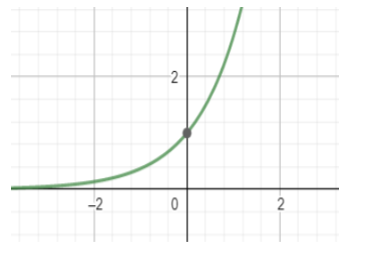
Find the range of function f(x) where f(x) = ${{e}^{x}}$ in [0, 1].
Answer
604.8k+ views
Hint: We have to first check the continuity of the function in the given interval. Then we have to find the limits of the function at its extreme intervals.
Complete step-by-step answer:
So here we are given a function ${{e}^{x}}$ in [0, 1] and we have to find its range.
First we need to find if this function is continuous in [0, 1].
f (x) = ${{e}^{x}}$
f (0) = ${{e}^{0}}$
= 1
f (1) =${{e}^{1}}$
= e
As the limits exist in the interval and there are no corner points where the function becomes discontinuous, we can say that the function is continuous in the interval [0, 1].
Here the function f(x) = ${{e}^{x}}$ is increasing in nature, which means f(x+1)>f(x).
So f(1) > f(0)
f (0) = ${{e}^{0}}$
= 1
f (1) =${{e}^{1}}$
= e

This is the graph of ${{e}^{x}}$. We can see that the function tends to 0 when x tends to -∞. And when x tends to ∞ then the function ${{e}^{x}}$ also tends to infinity. It intersects the y axis at the point (0,1) which means when the value of x = 0 , then the value of the function is 1.
We can see this is an increasing function and it is continuous in the interval [0, 1].
Therefore the range of the function f(x) = ${{e}^{x}}$ is [0, 1]
Note: We must remember the graphs of ${{e}^{x}}$ and ${{e}^{-x}}$ as they are very much important for boards as well as competitive exams. Where ${{e}^{x}}$ is always increasing in nature and on the other hand ${{e}^{-x}}$ is always decreasing in nature. They are also called exponential graphs, which are used to model populations.
Complete step-by-step answer:
So here we are given a function ${{e}^{x}}$ in [0, 1] and we have to find its range.
First we need to find if this function is continuous in [0, 1].
f (x) = ${{e}^{x}}$
f (0) = ${{e}^{0}}$
= 1
f (1) =${{e}^{1}}$
= e
As the limits exist in the interval and there are no corner points where the function becomes discontinuous, we can say that the function is continuous in the interval [0, 1].
Here the function f(x) = ${{e}^{x}}$ is increasing in nature, which means f(x+1)>f(x).
So f(1) > f(0)
f (0) = ${{e}^{0}}$
= 1
f (1) =${{e}^{1}}$
= e

This is the graph of ${{e}^{x}}$. We can see that the function tends to 0 when x tends to -∞. And when x tends to ∞ then the function ${{e}^{x}}$ also tends to infinity. It intersects the y axis at the point (0,1) which means when the value of x = 0 , then the value of the function is 1.
We can see this is an increasing function and it is continuous in the interval [0, 1].
Therefore the range of the function f(x) = ${{e}^{x}}$ is [0, 1]
Note: We must remember the graphs of ${{e}^{x}}$ and ${{e}^{-x}}$ as they are very much important for boards as well as competitive exams. Where ${{e}^{x}}$ is always increasing in nature and on the other hand ${{e}^{-x}}$ is always decreasing in nature. They are also called exponential graphs, which are used to model populations.
Recently Updated Pages
Master Class 12 Business Studies: Engaging Questions & Answers for Success

Master Class 12 Economics: Engaging Questions & Answers for Success

Master Class 12 English: Engaging Questions & Answers for Success

Master Class 12 Maths: Engaging Questions & Answers for Success

Master Class 12 Social Science: Engaging Questions & Answers for Success

Master Class 12 Chemistry: Engaging Questions & Answers for Success

Trending doubts
Which animal has three hearts class 11 biology CBSE

1 Quintal is equal to a 110 kg b 10 kg c 100kg d 1000 class 11 physics CBSE

The camels hump is made of which tissues a Skeletal class 11 biology CBSE

Discuss the various forms of bacteria class 11 biology CBSE

Bond order ofO2 O2+ O2 and O22 is in order A O2 langle class 11 chemistry CBSE

Draw a diagram of nephron and explain its structur class 11 biology CBSE




